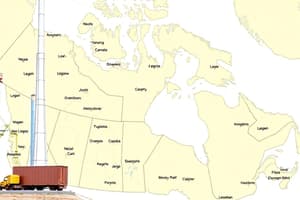Podcast
Questions and Answers
What type of industry is involved in the extraction of raw materials from the Earth?
What type of industry is involved in the extraction of raw materials from the Earth?
- Secondary industry
- Tertiary industry
- Primary industry (correct)
- Quaternary industry
Which of the following best describes the role of tertiary industries?
Which of the following best describes the role of tertiary industries?
- Transforming raw materials into finished goods
- Manufacturing durable goods
- Providing services to consumers (correct)
- Extracting natural resources
What factor is NOT typically influential in the location of industries?
What factor is NOT typically influential in the location of industries?
- Access to cultural centers (correct)
- Climate conditions
- Availability of raw materials
- Proximity to transportation networks
How does industrialization primarily affect economic conditions?
How does industrialization primarily affect economic conditions?
Which aspect of industries is becoming increasingly important in their operation?
Which aspect of industries is becoming increasingly important in their operation?
What is a significant consequence of the growth of the service sector in developed economies?
What is a significant consequence of the growth of the service sector in developed economies?
Which of the following does NOT classify as a primary industry?
Which of the following does NOT classify as a primary industry?
What primarily drives the development of industries?
What primarily drives the development of industries?
Flashcards
What is geography?
What is geography?
The study of the Earth's surface, including its physical features, inhabitants, and distribution of phenomena.
What is physical geography?
What is physical geography?
Geography that focuses on the Earth's natural components like climate, landforms, and water bodies.
What is human geography?
What is human geography?
Geography that focuses on human activities like population, culture, and economies.
What are industries?
What are industries?
Signup and view all the flashcards
What are primary industries?
What are primary industries?
Signup and view all the flashcards
What are secondary industries?
What are secondary industries?
Signup and view all the flashcards
What are tertiary industries?
What are tertiary industries?
Signup and view all the flashcards
How does geography impact industries?
How does geography impact industries?
Signup and view all the flashcards
Study Notes
Geography
- Geography is the study of Earth's surface, features, inhabitants, and phenomenon distributions.
- It's comprised of physical geography (climate, landforms, water), human geography (population, culture, economies), and regional geography.
- Geographic factors (location, climate, resources) impact economic activities and development.
- Location is vital for trade routes, market access, and resource acquisition.
- Topography and climate influence agriculture and resource extraction.
- Regional variations in these factors explain cultural and societal diversity.
Industries
- Industries transform raw materials into finished goods or services.
- Industries are categorized as primary (extractive), secondary (manufacturing), and tertiary (service).
- Primary industries extract Earth resources (agriculture, mining, forestry).
- Secondary industries process raw materials into finished products (manufacturing, construction, processing).
- Tertiary industries provide services (retail, transportation, communication, finance).
- Industrial development relies on resources, technology, and market demand.
- Industrialization leads to economic growth, job creation, and improved living standards.
- Industrial activities can cause pollution.
- Geographic factors (resources, labor, transportation) influence industrial location and growth.
- Global competition and trade agreements affect industry location and output.
- Innovations and technology continually change industries.
- The service sector often grows while manufacturing declines in developed countries.
- Sustainability and environmental concerns are crucial for industrial development and operation.
Interplay of Geography and Industries
- Geographic factors (resources, transportation, climate) affect industrial location.
- Industries modify the landscape through infrastructure, pollution, and land use changes.
- Resource availability dictates the kind and scale of industries.
- Industrial development impacts human settlement and population distribution.
- Trade routes, following geographic paths, are crucial for moving goods.
- Geographic limitations (disasters, resources, accessibility) can hinder industrial success.
- Geographic areas become industry hubs due to expertise, infrastructure, or history.
Studying That Suits You
Use AI to generate personalized quizzes and flashcards to suit your learning preferences.




